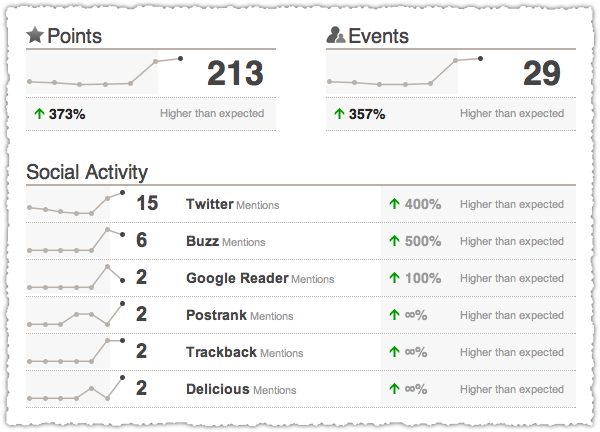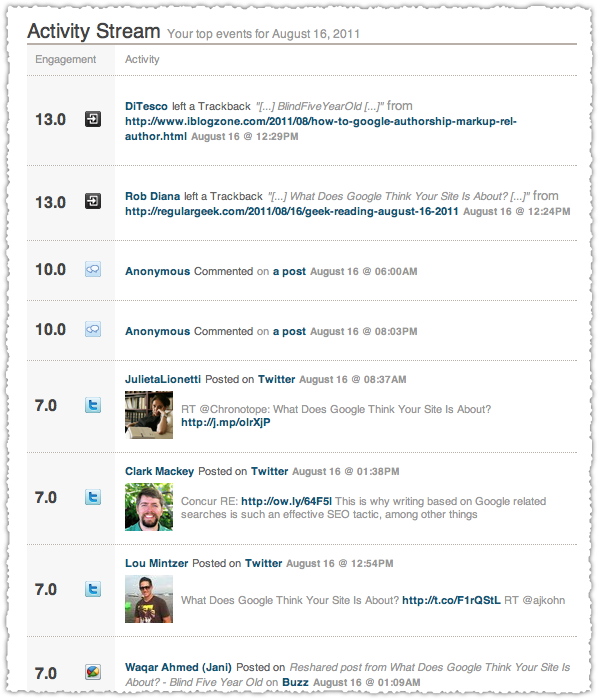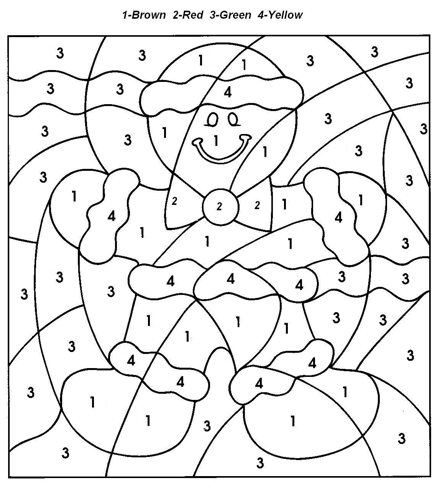Is Google building an influence metric? I think so. And they’re doing it by mapping the engagement graph.
Connecting the Dots
On June 3rd Google acquired PostRank. On June 7th Google began supporting authorship. On June 28th Google began to highlight authors in search results, the same day they launched launched Google+.
The next day +1 data began to appear in both Google Webmaster Tools and Google Analytics. On August 9 Google simplified authorship markup for single author sites and blogs. On August 24 Google connected the +1 button to Google+.
Finally, on September 15, Google rejiggered the Links section on Google+ profiles. The last change created three sections of links ‘Other profiles’ (Identity), ‘Contributor to’ (Authorship) and ‘Recommended link’.
Taken together I see a company aggressively building a new way to measure authority, influence and engagement.
What is PostRank?

The name itself is fairly self-explanatory, don’t you think? The service ranks blog posts. Here’s how PostRank describes it.
The social web connects people where they share, critique and interact with content and each other. PostRank is the largest aggregator of social engagement data in the industry.
Our platform tracks where and how users engage, and what they pay attention to — in real-time. PostRank social engagement data measures actual user activity, the most accurate indicator of the relevance and influence of a site, story, or author.
The emphasis is mine but , seriously, can it get any more clear? With this acquisition in place Google’s emphasis on identity and authorship makes perfect sense.
PostRank Data
If you’re a PostRank Analytics user you’re still getting a daily engagement report which gives a fair amount of insight into what is collected and tracked.

Social Activity is essentially an aggregate dashboard report. Directly below this is the Activity Stream.

The data here is rich and ripe for further analysis. Google now knows who, how, where and when someone reacted to a piece of content.
The Ws

I’ll bastardize the standard Five Ws journalism concept for my own purposes. Google wants to know who wrote the content, when and where was it published, what it was about and how it was received. (There’s an Inception like element here since how spawns another set of Ws.)
Google has long understood the when and where through their normal crawling and indexing activities. The what is an ongoing refinement process of relevance using various natural language processing and machine learning techniques. What is … what made Google the leader in the search.
Google+ and rel=”author” give Google the who (identity and authorship matter) and PostRank tells Google how that content was acted on.
The Engagement Graph
What we’re seeing is the emergence of an engagement graph. (I know, like we need another graph, right?) I think this differs from your social graph since many of the people who engage with your content are not part of a traditional social graph. For example, I don’t know everyone who bookmarks my content on Delicious.
An analysis of engagement might also help to mitigate social graph manipulation. Isn’t it curious how a minute after some sites publish a blog post they’ve already generated 20+ Tweets? Robo-syndication represents a very low level of engagement. Personally, I’d handicap any resulting engagement based on the manipulation of social proof. But I digress.
Mapping and measuring engagement is a difficult business. PostRank was able to create a very simple scoring metric. Activities were scored based on the level of engagement: Trackback (13), Comment (10), Tweet (7), Bookmark (5).
Google can do far more with the PostRank data and create a nuanced scoring metric. Was the trackback from a respected blog? Was it linked to contextually within the post or as part of an automated ‘related links’ block?
Was the comment from someone with subject matter expertise, authority and influence? What were the contents and sentiment of that comment? Was the comment free of spelling and grammatical errors? Did it include a link?
Who Tweeted the content? How influential is that person? Are they a subject matter expert in this area? What is the velocity of Tweets for that individual? The latter could be very interesting. You could conceivably apply a type of PageRank metric to a stream of Tweets, dividing the influence of a Tweet by the number of Tweets delivered within a specified time frame.
Beyond these silos they’ll likely look at whether it’s the same people engaging with your content again and again. The diversity of engagement should be a positive signal, whereas a very uniform engagement profile might raise some red flags. If you haven’t already figured it out, many of the same principles of the link graph apply to the engagement graph.
Of course Google will add other sources to the mix including +1 button data and all Google+ interactions. They paint a picture of influence by applying a deep analysis of engagement against a large data set of actions from verified authors.
Influence By Numbers?

The debate about influence is as hot as ever. Does your Klout or PeerIndex number really provide an accurate picture of influence? I think these metrics are interesting but I certainly wouldn’t rely on them. In fact, AdAge recently had to change their Power 150 calculation because the PostRank API was no longer available. (Yeah, Google doesn’t seem to want to share this data. That should tell you something.)
A recent blog post by Mark Schaefer was refreshingly honest and insightful about the AdAge ‘apocalypse’.
I think this pokes about at a recent theme of this blog — social proof and the fact that oftentimes on the social web a numerical rating provides a more important symbol of accomplishment than actual accomplishment. But this time it really hit home. Even if it’s a fake badge, the business benefits of being on the list can be real.
I can’t think this is Google’s view of influence. In fact, I picture a passionate lecture about why this is completely and utterly wrong. It’s a meritocracy not a popularity contest. No, I don’t think that Google will be releasing an influence number. Ever. But that doesn’t mean it doesn’t exist.
Influence will exist where it counts most, in search results.
TL;DR
The launch of Google+, the promotion of rel=”author” and the acquisition of PostRank make it clear that Google is mapping the engagement graph and establishing a new metric of influence that will impact search results.
The Next Post: Worst SEO Title Ever
The Previous Post: 4 Search Trends To Watch

3 trackbacks/pingbacks
Comments About Google Influence Metric
// 4 comments so far.
Mark W Schaefer // September 19th 2011
Superb post. Thanks for carrying on the conversation and expanding on it!
AJ Kohn // September 21st 2011
Mark, thank you for the refreshingly unvarnished blog post as well as your Tweet. I appreciate both.
Max Minzer // May 03rd 2012
https://analytics.postrank.com: “PostRank services have been sunset as of May 1, 2012”
Great images (as always), AJ!
AJ Kohn // May 03rd 2012
Yeah, I was sorry to see them discontinued Max but was actually surprised they let it go for this long.
Sorry, comments for this entry are closed at this time.
You can follow any responses to this entry via its RSS comments feed.